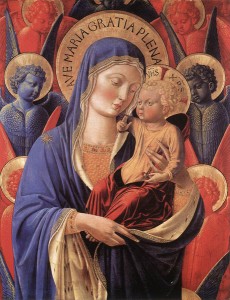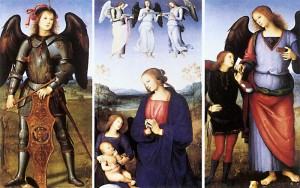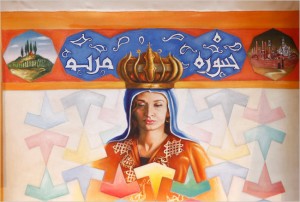Queen of the Heavenly Host, Defender of our souls, we thy servants offer to thee songs of victory and thanksgiving, for thou, O Mother of God, hast delivered us from dangers.
Many people think of devotion to the Virgin Mary as a strictly Catholic thing; indeed, ridicule of her is often a way of attacking the Church. During the buildup to the American Revolution, statues of George III were festooned with rosaries in reaction to the King’s Quebec Act, granting freedom of religion to the French Catholics of Canada. But in fact, veneration of the Mother of God not only goes back to the earliest days of Christianity, but also extends today far beyond the visible boundaries of the Catholic Church.

GOZZOLI, Benozzo, Madonna and Child among Seraphim and Cherubim, c. 1460, tempera on panel, 84.4 x 50.6 cm, Institute of Arts, Detroit
Eastern Orthodoxy — those Churches in communion with the Patriarchate of Constantinople, including the Greek, Antiochian, Russian, Serbian, Bulgarian and Romanian Orthodox — vies with Catholicism in its devotion to the Virgin. As Sergei Bulgakov writes: “Mary is not merely the instrument, but the direct positive condition of the Incarnation, its human aspect. Christ could not have been incarnate by some mechanical process, violating human nature. It was necessary for that nature itself to say for itself, by the mouth of the most pure human being: ‘Behold the handmaid of the Lord, be it unto me according to Thy word'” (The Orthodox Church, p.116). The Orthodox accept the Perpetual Virginity of Mary, delight in calling her Theotokos (“Mother of God”), and, in common with Byzantine Catholics, invoke her constantly in every liturgy.
With their Eastern Catholic counterparts too, they have a number of unique devotions to Mary. Most prominent is the Akathistos, a long hymn in her honor composed by St. Romanos in the 6th century. It is used also in the liturgy, particularly during Lent, and on a nightly basis by certain monasteries, and as a private devotion by laymen. Such Russian Orthodox Saints as St. Seraphim of Sarov used a devotion equivalent to our Rosary called the “Rule of the Mother of God.” This consists of the recitation of 150 Hail Marys, punctuated by meditations on various Marian mysteries. Rather than beads, it is prayed while counting off a number of knots on a string.
Icons of the Virgin — often miraculous — as well as healing springs and apparition sites, are frequently the centers of Eastern Orthodox shrines. Typical of these are Our Lady of Kazan (which, after theft in 1905, and stints at Fatima and John Paul II’s desk, was returned to Kazan Cathedral in 2004); St. Mary of the Spring in Istanbul; Our Lady of Tinos in Greece; and Kykkos Monastery on Cyprus. There are several shrines venerated jointly by Catholics and Orthodox, such as Our Lady of Częstochowa in Poland and Pochaiv in Ukraine. Processions too, often with icons, form a very big part of Eastern Orthodox Marian devotion.
Among the “Non-Chalcedonian” or “Lesser Eastern” Churches (Armenian, Syriac, Coptic, Ethiopian, and Malankaran Orthodox), devotion to the Virgin is also extremely strong. Their liturgies are filled with Marian feasts and prayers. Ironically, the Assyrian Church, which descends from the Nestorians, also venerates the Virgin. There are such shrines as the Ethiopian St. Mar of Axum, the Coptic shrines of Our Lady of Zeitoun and of Haret Zuweila, and the Malankaran Kattanhira chapel in India. All of these also have their Marian processions. It may be said that all the Churches with indisputable claim to the Apostolic Succession and Sacraments likewise venerate the Mother of God, and believe in her Perpetual Virginity. (See section on APOLOGETICS).

PERUGINO, Pietro, Polyptych of Certosa di Pavia (details), c. 1499, Oil and tempera on poplar panel, National Gallery, London
But what of the communities that emerged from the 16th century Protestant Revolt? As mentioned in APOLOGETICS [link], the early “Reformers” held most of the Apostolic teachings on the Virgin, but generally denied her intercession and devotions to her based upon it. In Anglicanism, however, this, as much else, was very ambiguous. From its commencement, certain elements of the Church of England held to a more “Catholic” line on devotion to the Virgin than did many of their co-religionists or the Continental Protestants. The so-called “Caroline Divines,” 17th century theologians such as Lancelot Andrewes, Jeremy Taylor, and Thomas Ken, continued to pray for her intercession, and the form of Evening Prayer in the Book of Common Prayer included (and includes) the Magnificat. Deeply Marian before the revolt, England continued to boast many churches named after Mary, as well as “Lady Chapels” in most parish churches. Some Marian feasts remained on the English calendar.
The Oxford Movement of the 19th century and the rise of Anglo-Catholicism with its reemphasis on the Apostolic claims of the Church of England saw a concomitant rebirth of Marian devotion. Anglican religious orders were founded in her name, the Society of Mary was founded especially to invoke her aid, and in the early 20th century, Fr. Alfred Hope Patten refounded the shrine of Our Lady of Walsingham; a Catholic shrine was opened alongside, and once again pilgrimages to that shrine became part of English life. The statue of Our Lady of Pew was reinstalled at Westminster Abbey.
Luther himself retained his reverence for the Virgin Mary in some degree, alongside his continuing to accept her perpetual virginity and Immaculate Conception. Although considering Catholic devotion to her to be excessive, he nevertheless called for retaining her statues in churches and some of her feast days. Many of his later followers lost sight of these views. However, as with Anglicanism, the late 19th and early 20th centuries saw the rise of a “High Church” within Lutheranism; those Lutheran communities who claim the Apostolic Succession also tend to revive Luther’s views on Mary — some go further, and even offer her due veneration.
John Calvin continued to call Mary the Mother of God and believed in her Perpetual Virginity, though not in her Immaculate Conception, ordered the removal of her images from the churches he controlled, and expunged her holidays with all others from the calendar. His successors were more radical still. Many seemed to take an utter delight, for instance, in asserting that Our Lady had children other than Jesus, and that she was no different from any other woman.
But the 19th century saw a High Church Movement arise among both Scottish (Presbyterian) and German, Swiss, and Dutch (Reformed) Calvinists. Emphasising the centrality of the Sacraments and continuity with the Pre-Reformation Church, more radical members of such currents as the Scottish Church Society and the Mercersburg Theology began to find their way back to Calvin’s views. Some went (and go) even further.
Much of the move against Mary after the Reformation was driven by anti-Catholicism, political and religious. Those groups most heavily influenced by Calvinism, to include what we would today call Evangelicals, were most studious in ignoring her. But as anti-Catholicism has lessened among such folk today, some are reaching a heightened understanding of Mary.
In the December 2003 issue of Christianity Today, Timothy George, dean of the Baptist Beeson Divinity School at Samford University in Birmingham, Ala., wrote that “it is time for evangelicals to recover a fully biblical appreciation of the Blessed Virgin Mary and her role in the history of salvation, and to do so precisely as evangelicals…We may not be able to recite the rosary or kneel down before statues of Mary, but we need not throw her overboard.” He went on to quote early 20th-century Southern Baptist New Testament scholar, A.T. Robertson’s opinion that Mary “has not had fair treatment either from Protestants or Catholics.” He said that although Catholics have “deified” the Virgin, evangelicals have “coldly neglected” her. Commenting on this assertion, George declared that “We have been afraid to praise and esteem Mary for her full worth, lest we be accused of leanings and sympathy with Catholics.” He then summed up his view: “We need not go through Mary in order to get to Jesus, but we can join with Mary in pointing others to him.” A number of books aiming to explain the Virgin to Evangelicals and other Protestants have been published in recent years.

The Muslim version of Catholic Mary, with verses from the Koran, in the Italian city of Siena. This is the “Virgin Mary’s face”, in Arabic. The title is from the 19th chapter of the Koran, which is dedicated to the Madonna. In her crown, an Arab crescent, the symbol of Islam, is placed on one side of the cross. The Star of David, the symbol of Judaism, is on the other side.
Outside the bounds of Christendom, Mary has her devotees as well. In the Koran, the 19th Sura, Maryam, is devoted to the story of Mary, John the Baptist, and the birth of Christ, in fairly similar manner to the Gospels. Mary is presented as being Immaculately Conceived, and as giving birth to Jesus while remaining a Virgin. Indeed, the Virgin is the woman mentioned most throughout the Koran — although the Sura claims that to hold Jesus as God is blasphemy, the book claims neither a Virgin Birth for Mohammed, nor the Immaculate Conception for his Mother.
Although Sunni Islam generally frowns upon the idea of intercession by the Saints, Shiite Islam does not — many of the latter routinely invoke the Virgin. In Pakistan, not only is the Catholic National shrine of Mariamabad much resorted to by Muslims, there is an exclusively Islamic shrine in her name at Murree. The Syrian shrine at Saydnaya reports much the same.
Indeed, throughout Asia, the many Catholic and other Christian Marian shrines in India, Sri Lanka, Indonesia, China, Japan, Korea, and elsewhere find not only innumerable Muslim but Hindu and Buddhist pilgrims as well — all seeking healing or blessings from the Mother of the Christian God. While this may not make a great deal of sense theologically for members of those religions, they are drawn by the indisputable fact that blessings rain down upon all who venerate Mary in those places. Her Divine Maternity, and the qualities she represents of gentleness, strength, and purity outweigh anything else in the minds of such non-Christian devotees.
The Queen of Angels Foundation, in similar fashion, hopes to open its planned procession and other devotions not only to Catholics of all rites, but to Orthodox, Anglican and all other Christians who venerate the patroness of this City, as well as to all other Angelenos who feel the need for her protection.
Links
- Non-Catholic Websites Regarding The Virgin Mary
- Icons of the Theotokos
http://www.oca.org/FStheotokos.asp?SID=4 - Feasts of the Mother of God in the Armenian Church
http://www.armenianchurch-ed.net/feasts/the-mother-of-god/ - The Holy Virgin Mary in the Syriac Orthodox Church
http://syrianorthodoxchurch.org/library/essays/the-holy-virgin-mary-in-the-syrian-orthodox-church - Shrine of Our Lady of Saydnaya, Syria
http://www.pbase.com/mansour_mouasher/saydnaya - Holy Family in Egypt
http://stmarkboston.org/resources/about-the-coptic-church/117-the-holy-family-in-egypt - Anglican Society of Mary
http://www.societyofmary.net/ - Shrine of Our Lady of Walsingham
http://www.walsingham.org.uk/ - Shrine of Our Lady of Haddington
http://www.haddingtoncc.org.uk/aisle.htm - Shrine of Our Lady of the Park
http://www.penzancecatholicchurch.org/ladyepark/ - Shrine of St. Mary, Willesden
http://www.stmarywillesden.org.uk/Virgin5.html - Ecumenical Society of the Blessed Virgin Mary
http://www.esbvm.org.uk/ - Muslim Shrine of Murree
http://campus.udayton.edu/mary/resources/marianshrineinpakistan.htm - Shrine of Mariamabad, Pakistan
http://en.wikipedia.org/wiki/National_Marian_Shrine,_Mariamabad - Eastern Catholic Churches in Los Angeles Dedicated to the Virgin
- Armenian Catholic Church of Our Lady Queen of Martyrs
http://armenianeparchy.org/ourlady/ - St. Mary’s Byzantine Catholic Cathedral
http://cathedralofstmary.blogspot.com/ - St. Mary Coptic Catholic Church
http://stmaryccc.com/ - Nativity of the Blessed Virgin Mary Ukrainian Catholic Church
http://www.ukrainiancatholicla.org/ - Our Lady of Mount Lebanon Maronite Catholic Cathedral
http://www.ourladyofmountlebanon.com/ - Eastern Orthodox Church in Los Angeles Dedicated to the Virgin
- Holy Virgin Mary Russian Orthodox Cathedral
http://www.hvmla.org/ - Protection of the Holy Virgin Russian Orthodox Church
http://pokrovchurch.org/ - St. Mary’s Jacobite Syrian Orthodox Church
http://www.stmarysla.org/ - St. Mary’s Malankara Syrian Orthodox Church
http://www.stmarysorthodoxla.com/ - Holy Virgin Mary and St. Pishoy Coptic Orthodox Church
http://www.theotokos.org/ - Virgin Mary Ethiopian Orthodox Church
http://www.ethiovirginmary.org/index_a.htm - St. Mary’s Ethiopian Orthodox Church
http://www.ethiopianorthodoxchurch.org/ - Anglican and Episcopal Churches in Los Angeles Dedicated to the Virgin
- St. Mary of the Angels Anglican Catholic Church
http://www.stmaryoftheangels.org/ - St. Mary in Palms Episcopal Church
http://www.stmarypalms.org/
Videos
-
- The Second Vatican Council committed the Catholic Church irrevocably to following the path of the ecumenical venture. This is what Benedict XVI recently said during his encounter with the Ecumenical Delegation of the Lutheran Church of Finland.